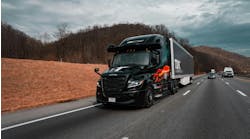Nikola’s notable achievements
Girsky, the former Nikola chairman who took on the role just as the FCEV began production in the summer of 2023, noted what the OEM accomplished was a net positive for the clean trucking movement.
“With the dedication of our employees and support from our partners, Nikola has taken significant steps to move zero-emissions transportation forward, including bringing the first commercially available Class 8 hydrogen fuel cell electric trucks to market in North America and developing the HYLA hydrogen refueling highway, connecting Northern California to Southern California,” Girsky said.
He also cited that the Nikola fleet customers surpassed 3.3 million miles driving the BEV and FCEV models and that the HYLA stations dispensed more than 330 metric tons of hydrogen.
Customers included JB Hunt, which started with three FCEVs and purchased 20 more last fall, and Biagi Brothers, which reportedly received 15 of the first FCEVs produced at the end of 2023.
Even with tax incentives, both companies have sunk many millions into the FCEVs. Whether they will get the support they need in April to continue using the FCEVs—and generating enough revenue to justify the investment—is as of now unknown.
A direct question as to what will become of Nikola customers was met with a copy-paste of a press release passage:
“Subject to Court approval, the Company intends to continue certain limited directly provided (non-dealer) service and support operations for trucks currently in the field, including certain HYLA fueling operations through the end of March 2025. Thereafter, the Company will need one or more partners to support such activities.”
In response, Fleet Maintenance asked: Should we infer that if no such partner is found, these folks are essentially out the cost of the truck? There's a recurring valve issue on at least one owner's truck that has left his FCEV down for extended periods. Does Nikola intend to help people like this recoup investment in any scenario?
We have not received a reply as of yet but will be sure to provide an update if they do.
Ahead of its time?
The FCEV features a range of up to 500 miles per fill-up and was celebrated for proving hydrogen could become a clean alternative to fossil fuels. The problem has always been the high cost of hydrogen, especially the truly “green” kind made from renewable sources like hydro or solar power. In California last October, a kilogram of retail hydrogen was over $34 due to supply disruptions, according to S&P Global. The U.S. Department of Energy is working toward bringing the production cost of clean hydrogen down to $1/kg by 2031, but that is six years away. And Nikola appears out of time and money.
It's not the only casualty of hydrogen’s immature supply chain.
Hyzon Motors, a competitor in the hydrogen transportation space, began its dissolution process before last Christmas and is reportedly searching for a company to buy its assets. While Nikola built its trucks in Coolidge, Arizona using a cabover design borrowed from Iveco, Hyzon placed fuel-cell technology on existing Class 8 semis and refuse trucks.
Global leaders in trucking, such as Daimler Tuck, Paccar, and Volvo have had a more methodical approach. Daimler, which has a joint venture with Volvo to develop fuel cells, isn’t planning a production-ready FCEV until around 2030. Hyundai, which also has hydrogen-powered passenger vehicles, is running smaller-scale deliveries between its Georgia manufacturing sites with its Xcient Class 8 fuel cell truck. The Korean-based auto- and truck maker has nearly 50 Xcients in Switzerland, which as of June 2024 accrued 621,000 miles (10 million km). The project started in 2020.
The Trump factor
The Advanced Clean Fleets regulations decreed by California Gov. Gavin Newsome and the California Air Resources Board would have forced truck operators in the state to adopt zero-emission vehicles; the EPA waiver that would have allowed the environmental authoritarianism was rescinded when President Donald Trump began his second term. Trump had promised to end “electric vehicle mandates” and has put in place cabinet members, such as EPA Administrator Lee Zeldin and Secretary of Transportation Sean Duffy, to ensure climate agendas were not prioritized for U.S. economic health. To that end, federal money streaming to zero-emission projects—via laws passed during the Biden era—has been dammed up for the time being. That in turn has slowed investments in clean technology.
The New York Times reported Nel, a manufacturer of electrolyzers used to produce hydrogen, is not going forward with building its planned Michigan gigafactory, due to uncertainty around tax credits.
“It’s not down to one single thing — there’s just too much uncertainty, and that prevents boards and steering committees from approving business cases,” Nel CEO Hakon Volldal told the paper of record.
Plug Power, a green hydrogen producer based in New York has faced similar challenges and has missed revenue estimates.
None of this means hydrogen will never be a suitable form of fuel, though by the time it does, the question is how much more advanced battery technology will be. If they have range parity, what fleet would want to deal with the cost, as well as the maintenance and technology issues, of fuel cells and hydrogen storage?





